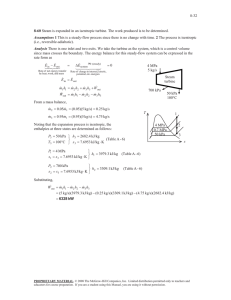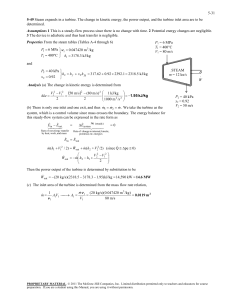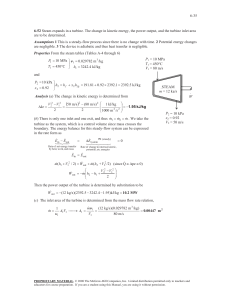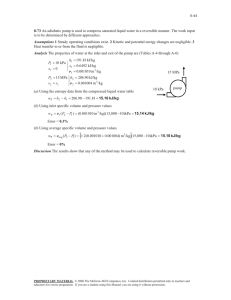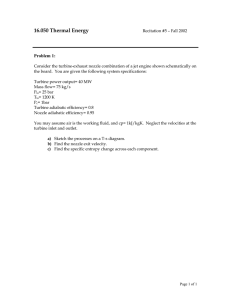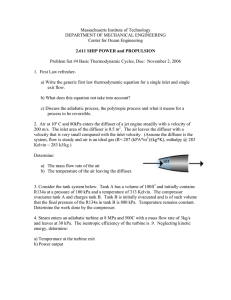ME 24-221 THERMODYNAMICS I Solutions to
advertisement
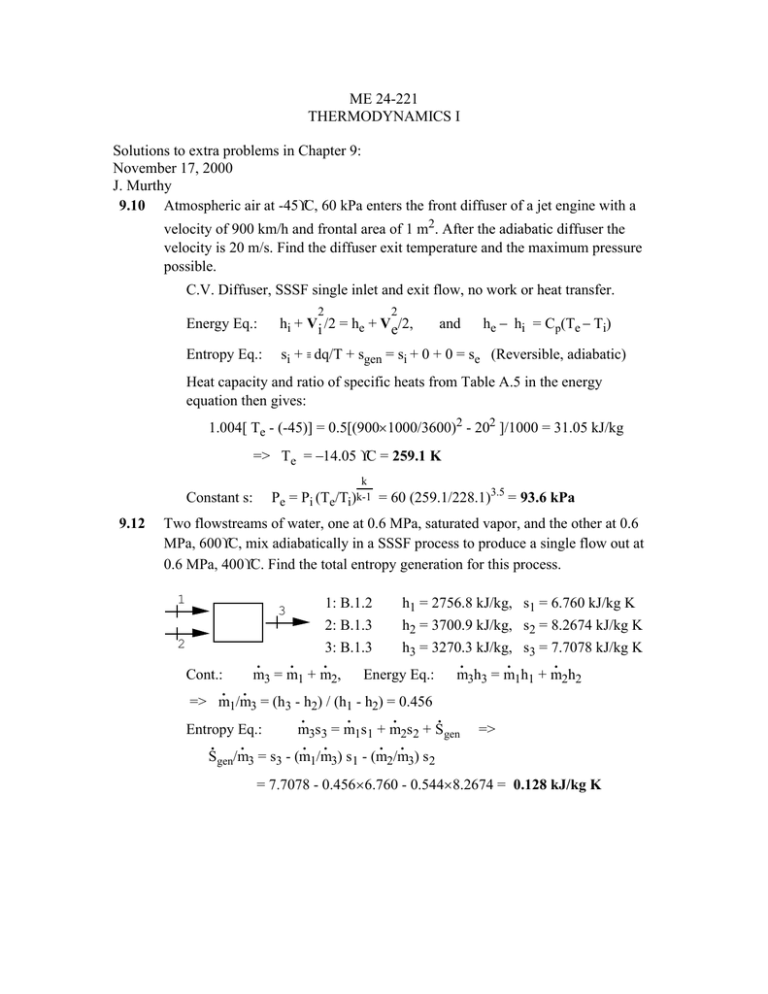
ME 24-221 THERMODYNAMICS I Solutions to extra problems in Chapter 9: November 17, 2000 J. Murthy 9.10 Atmospheric air at -45°C, 60 kPa enters the front diffuser of a jet engine with a velocity of 900 km/h and frontal area of 1 m2. After the adiabatic diffuser the velocity is 20 m/s. Find the diffuser exit temperature and the maximum pressure possible. C.V. Diffuser, SSSF single inlet and exit flow, no work or heat transfer. 2 2 he − hi = Cp(Te − Ti) Energy Eq.: hi + Vi /2 = he + Ve/2, Entropy Eq.: si + ∫ dq/T + sgen = si + 0 + 0 = se (Reversible, adiabatic) and Heat capacity and ratio of specific heats from Table A.5 in the energy equation then gives: 1.004[ Te - (-45)] = 0.5[(900×1000/3600)2 - 202 ]/1000 = 31.05 kJ/kg => Te = −14.05 °C = 259.1 K Constant s: 9.12 Pe = k k-1 Pi (Te/Ti) = 60 (259.1/228.1)3.5 = 93.6 kPa Two flowstreams of water, one at 0.6 MPa, saturated vapor, and the other at 0.6 MPa, 600°C, mix adiabatically in a SSSF process to produce a single flow out at 0.6 MPa, 400°C. Find the total entropy generation for this process. 1 1: B.1.2 h1 = 2756.8 kJ/kg, s1 = 6.760 kJ/kg K 2: B.1.3 h2 = 3700.9 kJ/kg, s2 = 8.2674 kJ/kg K 3: B.1.3 h3 = 3270.3 kJ/kg, s3 = 7.7078 kJ/kg K . . . . . . m3 = m1 + m2, Energy Eq.: m3h3 = m1h1 + m2h2 3 2 Cont.: . . => m1/m3 = (h3 - h2) / (h1 - h2) = 0.456 . . . . Entropy Eq.: m3s3 = m1s1 + m2s2 + Sgen . . . . . . Sgen/m3 = s3 - (m1/m3) s1 - (m2/m3) s2 => = 7.7078 - 0.456×6.760 - 0.544×8.2674 = 0.128 kJ/kg K 9.19 Air at 327°C, 400 kPa with a volume flow 1 m3/s runs through an adiabatic turbine with exhaust pressure of 100 kPa. Neglect kinetic energies and use constant specific heats. Find the lowest and highest possible exit temperature. For each case find also the rate of work and the rate of entropy generation. C.V Turbine. SSSF, single inlet and exit flows, q = 0. Inlet state: (T, P) vi= RTi/ Pi = 0.287 × 600/400 = 0.4305 m3/kg . . m = V /vi = 1/0.4305 = 2.323 kg/s The lowest exit T is for max work out i.e. reversible case Constant s => Te = k-1 Ti(Pe/Pi) k = 600 × (100/400) 0.2857 = 403.8 K ⇒ w = hi - he = CPo(Ti - Te) = 1.004 × ( 600 – 403.8) = 197 kJ/kg . . . WT = mw = 0.4305×197 = 457.6 kW and Sgen = 0 Highest exit T occurs when there is no work out, throttling q = ∅; w = ∅ 9.21 ⇒ hi - he = 0 ⇒ Te = Ti = 600 K . . 100 . = 0.924 kW/K Sgen = m (s e - si) = - mR lnPe/Pi = -2.323 × 0.287 ln 400 Air enters a turbine at 800 kPa, 1200 K, and expands in a reversible adiabatic process to 100 kPa. Calculate the exit temperature and the work output per kilogram of air, using a. The ideal gas tables, Table A.7 b. Constant specific heat, value at 300 K from table A.5 c. Constant specific heat, value at an intermediate temperature from Fig. 5.1 Discuss why the method of part (b) gives a poor value for the exit temperature and yet a relatively good value for the work output. air C.V. Air turbine. Adiabatic; q = 0, reversible: sgen = 0 i . Energy: w T = hi − he , Entropy Eq.: se = si W a) Table A.7: h i = 1277.8, Pri = 191.174 Turbine ⇒ P re = Pri × P e/Pi = 191.174 × 100/800 = 23.897 e ⇒ Te = 706 K, he = 719.9 kJ/kg w = hi - he = 557.9 kJ/kg b) k-1 )k Te = Ti (P e/Pi 1000.286 = 1200 = 662.1 K 800 w = CPo(Ti - Te) = 1.004(1200 - 662.1) = 539.8 kJ/kg c) Fig. 5.10 at a 1000 K: CPo a 32.5, CVo = CPo-R a 24.2 0.255 k = CPo/CVo a 1.343, Te = 1200 (100/800) = 706.1 K w = (32.5/28.97)(1200 - 706.1) = 554.1 kJ/kg In b) k = 1.4 is too large and Cp too small. 9.23 A supply of 5 kg/s ammonia at 500 kPa, 20°C is needed. Two sources are available one is saturated liquid at 20°C and the other is at 500 kPa, 140°C. Flows from the two sources are fed through valves to an insulated SSSFmixing chamber, which then produces the desired output state. Find the two source mass flow rates and the total rate of entropy generation by this setup. C.V. mixing chamber + valve. SSSF, no heat transfer, no work. . . . . . . Continuity Eq.: m1 + m2 = m3; Energy Eq.: m1 h1 + m2h2 = m3h3 . . . . Entropy Eq.: m1 s1 + m2s2 + Sgen = m3s3 T 1 2 MIXING 2 1 3 3 CHAMBER s State 1: Table B.2.1 h1 = 273.4 kJ/kg, s1= 1.0408 kJ/kg K State 2: Table B.2.2 h2 = 1773.8 kJ/kg, s2 = 6.2422 kJ/kg K State 3: Table B.2.2 h3= 1488.3 kJ/kg, s3= 5.4244 kJ/kg K . . . . m1 h1 +( m3 - m2)h2 = m3h3 => . . h3 - h2 m1 = m3 = 0.952 kg/s h1 - h2 . . . m2 = m3 - m1 = 4.05 kg/s . Sgen= 5 × 5.4244 – 0.95 ×1.0408 – 4.05 × 6.2422 = 0.852 kW/K 9.49 A certain industrial process requires a steady 0.5 kg/s of air at 200 m/s, at the condition of 150 kPa, 300 K. This air is to be the exhaust from a specially designed turbine whose inlet pressure is 400 kPa. The turbine process may be assumed to be reversible and polytropic, with polytropic exponent n = 1.20. a) What is the turbine inlet temperature? b) What are the power output and heat transfer rate for the turbine? c) Calculate the rate of net entropy increase, if the heat transfer comes from a source at a temperature 100°C higher than the turbine inlet temperature. C.V. Turbine, this has heat transfer, PVn = Const., n = 1.2 Air table A.5: Cp = 1.004 kJ/kg-K, R = 0.287 kJ/kg-K Exit: Te = 300K, Pe = 150 kPa, Ve = 200 m/s n-1 a) Process polytropic: Te / Ti = (Pe/Pi) n => Ti = 353.3 K . . . . b) 1st Law SSSF: mi(h+ V2/2)in + Q = mex(h+ V2/2)ex + WT Reversible shaft work in a polytropic process, Eq.9.15 and Eq.9.20 n 2 2 2 2 wT = −∫ v dP + ( Vi − Ve )/2 = − (Peve - Pivi) + ( Vi − Ve )/2 n-1 n 2 R(Te -Ti) − Ve /2 = 71.8 kJ/kg =− n-1 . . WT = mwT = 35.9 kW Assume Constant Specific Heat . . . 2 Q = m[CP (Te -Ti) − Ve /2 ] + WT = 19.2 kW . . TH = Ti + 100 = 453.3 K c) 2nd Law: dSnet/dt = m(se -si) - QH/TH, Te Pe se - si = Cpln - R ln = 0.1174 kJ/kg-K T P i i dSnet/dt = 0.5×0.1174 - 19.2/453.3 = 0.0163 kW/K T P n = k = 1.4 i n=1 e n = 1.2 v i n=1 e n = 1.2 s 9.60 A nozzle is required to produce a flow of air at 200 m/s at 20°C, 100 kPa. It is estimated that the nozzle has an isentropic efficiency of 92%. What nozzle inlet pressure and temperature is required assuming the inlet kinetic energy is negligible? C.V. Air nozzle: Pe, Te(real), Ve(real), ηs(real) 2 For the real process: hi = he + V e/2 or 2 Ti = Te + V e/2CP0 = 293.2 + 200 2/2 × 1000 × 1.004 = 313.1 K For the ideal process: 2 2 V es/2 = Ve/2ηs = 2002/2 × 1000 × 0.92 = 21.74 kJ/kg 2 and hi = hes + (V es/2) 2 Tes = Ti - V es/(2CP0) = 313.1 - 21.74/1.004 = 291.4 K k ⇒ 9.71 313.13.50 = 128.6 kPa P i = Pe (Ti/T es)k-1 = 100 291.4 A two-stage turbine receives air at 1160 K, 5.0 MPa. The first stage exit at 1 MPa then enters stage 2, which has an exit pressure of 200 kPa. Each stage has an isentropic efficiency of 85%. Find the specific work in each stage, the overall isentropic efficiency, and the total entropy generation. T 1 2s P 2ac 3ss 3s 3ac C.V. around each turbine for first the ideal and then the actual produces for stage 1: Ideal T1: s2s=s1 => Pr2 = Pr1P2/P1 = 33.297 2 P3 s ⇒ h2s = 789.93; wt1s = h2s - h1 = 441.04 w T1ac = ηwT1s = 374.88 kJ/kg ⇒ h2ac = 856.09 , Pr2ac = 44.57 P r3 = Pr2acP3/P2 = 8.915 ⇒ h3s = 544.49 , wT2s = 311.6 w T2ac = ηwT2s = 264.86 ⇒ h3ac = 591.23 , ° sT 3ac = 7.5491 T2s = 770 , T2ac = 830 , T3s = 540 , T3ac ≅ 585 For the overall isentropic efficiency we need the isentropic work: P r3ss = Pr1P3/P1 = 6.659 ⇒ h3ss = 500.97 wss = 730.0 η = (wT1ac + wT2ac)/wss = 0.876 ° - s° - R ln (P /P ) s T gen = s3 - s1 = sT 3 T1 3 1 200 = 7.5491 - 8.30626 - 0.287 ln = 0.1666 kJ/kg K 5000 9.72 A paper mill, shown in Fig. P9.72, has two steam generators, one at 4.5 MPa, 300°C and one at 8 MPa, 500°C. Each generator feeds a turbine, both of which have an exhaust pressure of 1.2 MPa and isentropic efficiency of 87%, such that their combined power output is 20 MW. The two exhaust flows are mixed adiabatically to produce saturated vapor at 1.2 MPa. Find the two mass flow rates and the entropy produced in each turbine and in the mixing chamber. H2O P1=4.5MPa H2O T .1=300°C 1 2 m1 T1 3 P2=8MPa T2=500°C . m2 T2 P3=1.2MPa 4 20MW Power output to electric generator P4=1.2MPa Insulated Mixer 5 P5=1.2MPa sat. vapor 3s: x3s = (6.2828 - 2.2165)/4.3067 = 0.9442 h3s = 798.6 + 0.9442 × 1986.2 = 2673.9 h1 = 2943.1 s1 = 6.2828 h2 = 3398.3 s2 = 6.7240 h5 = 2784.8 s5 = 6.5233 CV T1: wT1,s = h1 - h3s s3s = s1 ⇒ ⇒ wT1,s = 269.2 kJ/kg wT1,AC = 0.87 × 269.2 = 234.2 , h3,AC = 2708.9 =798.6 + x3AC × 1986.2 => x 3AC = 0.9618 s3AC = 2.2165 + 0.9618 × 4.3067 = 6.3586 , sgenT1 = 6.3586 - 6.2828 = 0.0758 kJ/kg K CV T2: wT2,s = h2 - h4s , s4s = s2 = 6.7240 4s: T4s = 226.7°C, h4s = 2881.1, wT2,s = 517.2, wT2,AC = 450.0 h4,AC = 2948.3 , s4AC = 6.8546, sgenT2 = 6.8546 - 6.7240 = 0.1306 kJ/kg K . . . . C.V mixer: mT1h3AC + mT2h4,AC = (mT1 + mT2)h5 . . ⇒ (mT1/mTot)(h3,AC - h4,AC) = h5 - h4,AC . . . . (mT1/mTot) = 0.683 , (mT2/mtot) = 0.317 . . . C.V. Total: m1h1 + m2h2 = 20 MW + mtoth5 . . mtot × 302.598 = 20MW ⇒ mtot = 66.094 kg/s . . . . . mtotsgen = mtots5 - mT1s3 - mT2s4 = 0.00747 mtot = 0.494 kW/K
